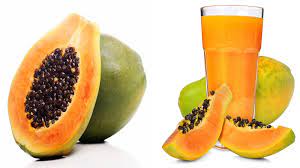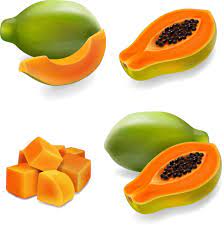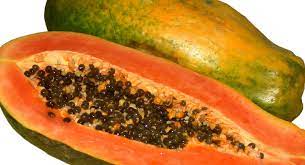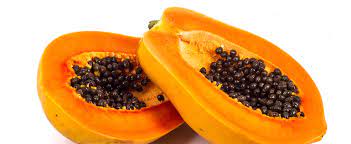FOOD AS MEDICINE – PAW-PAW
Carica papaya, (botanical) Pawpaw, (English) okwuru bekee, mgbigmbi (Igbo), Ibepe (Yoruba), gwanda, (Hausa) are all the various names given to this tropical fruit plant in various locations.
The papaya plant is not only widely cultivated everywhere, but also grows naturally, in and around our homes and in the wild due to human and animal actions. It is not a strange sight to see a new plant of Carica papaya, sprouting up in one’s backyard or at the village dumpsite. Though judged to be a tree, it is not woody as is factual of most trees, the plant is rather like a palm, especially at the trunk. The trunk is sturdy, particularly at the base and the mid-section, with leaf stalk scars dotted around it where the older leaves have previously fallen off. It can grow to between 26 and 33 feet with spirally coordinated long -stalked leaves restricted only at the top.
The papaya has male and female structures produced
by different plants, however, there are cases of hermaphroditic forms and other anomalies in sex distribution. Whereas the female flowers are considerably larger than male ones, the flowers are carried in the leaf axil with the male being multi flowered and the female producing just a few. Because they are sweet scented and open at night, it becomes easy to be pollinated by small birds, insects, and wind action.
The fruit of the papaya is large, shaped like a pear or generally cylindrical, green, and hard when not matured and ripe. It turns sunset yellowish, amber, or orange and soft when ripen, tastes sweet, can be eaten solo, added to several dishes like salsa, fruit salad, smoothies, added to lemonade, iced tea or water for a fruity flavor.
The mature unripe papaya fruit can also be enjoyed in various ways. For instance, it can be cooked like pumpkin, peeled when cooked and added to yam porridge, made into porridge with rich broth of dried fish, meat, and vegetables. Many health eaters would not miss the unripe papaya lunch for anything.
Eating the papaya fruit whether in its ripe or unripe state, comes with a lot of health benefits which according to experts include protection of the eye via the prevention of progressive age- related macular degeneration and also very helpful to asthma and certain kind of cancer suffers because of the high content of beta-carotene. It aids bone health because it helps in the absorption of vitamin K and calcium. Other health challenges said to be tackled by consumption of the ripe papaya comprise, both type 1 and type 2 diabetes, indigestion, heart disease, inflammation and is said to support skin and hair health.
As for the health benefits of the unripe or green papaya, it is said to be packed full of vitamins and phytochemicals especially papain and chymopapain which according to experts habour anti- bacterial and wound healing properties. Research has shown that some of these health conditions below can be helped by frequent consumption of the green papaya- digestive and pancreatic problems, dyspepsia, and hyperacidity. The green papaya fruit is also claimed to have very significant sensitivity to some infections caused by the activities of certain bacteria like staphylococcus aureus, bacillus cereus and shigella flexneri to mention but a few. It is also alleged to be very efficacious in reducing signs of early aging, improves lactation in new mothers, offers relief from menstrual pain and useful in cases of delayed or late periods.
The papaya leaves have also been credited with numerous health benefits whether as raw fresh juice from the leaves, tea, or as herbal mix with other leaves like guava or mango. The fresh raw juice of papaya is said to be very beneficial in the cure and management of dengue fever, malaria, and typhoid. It can also be of a huge benefit to anemic and diabetic patients and valuable as a detox drink as the high level of phytochemicals and flavonoids combine to purify the blood while improving blood circulation, protecting the liver and kidneys from inflammation.
The seeds are also medicinal and beneficial to the overall health and wellbeing as they are said to fight free radicals and as such shield us from common colds, cough and other respiratory diseases. They also help in overall health management and regulation of blood cholesterol
Though the seed is minty to the taste, but it not something you will find people wanting to take easily. However, to get the best out of it, it is suggested to have it ground and mixed with smoothies, teas, or any favourite food.
The roots are used as home remedies for various wellbeing purposes right from the olden times. It is usually dried, cut into small bit and boiled for about 20 munities, left to cool and then taken as a remedy for bladder issues, rheumatism, kidney disease, tooth aches and heart diseases because of its diuretic activities. The concoction can similarly be used as steam inhalation for malaria fever and other respiratory related issues.
From the above, there is no gain saying the fact the papaya plant not only serves as food but is fully loaded with unique health benefits starting from the leaves, the fruits to the roots. Its powerful antioxidant content help with most diseases especially those that come with age. It is said that, “among 14 vegetables and fruits known to have antioxidant properties, only the papaya has shown anticancer activities in breast cancer”.
So why wait, avail yourself the opportunity to benefit from this lavishly grown plant that can be easily found almost everywhere around you. If there is none around you, start today, take advantage of the rainy season, grow a couple of it around your home and do not forget to add it as part your desert in your next meal today.




